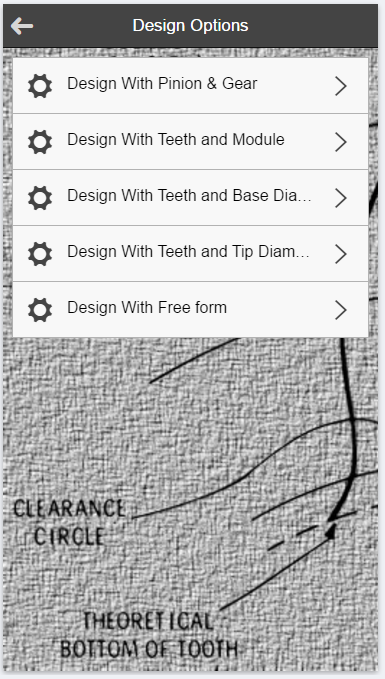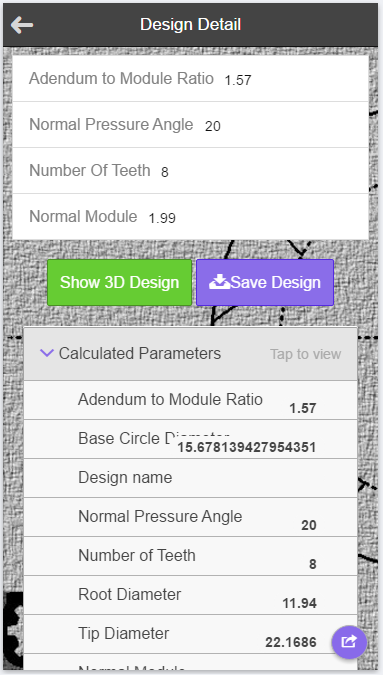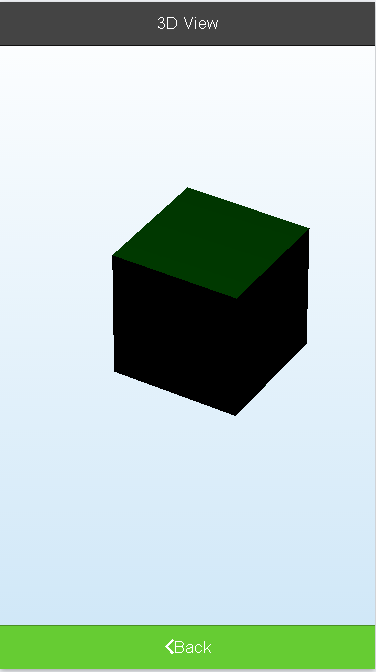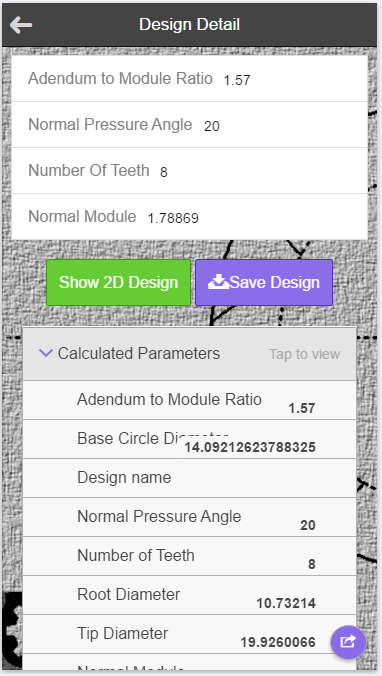Advertisement
Latest Version (Download)Table of Contents
Advertisement
Information
| Package | com.ionicframework.gear225190 |
| Version | 3.0.4 |
| Date Updated | 2022-04-11 |
| Size | 5.58 MB |
| Installs | 32 |
| Categories | Applicazioni, Produttività |
Screenshots
Description
Imparare, progettare, visualizzare evolvente ingranaggi, camme e forme in 3D.
The app allows you to design and visualize the involute Gear,Pinion and Rack geometry in 2D and 3D. In built functionality includes saving of designs on to your device to view anytime. The geometry generated is reliable.
[IMP Note]App doesn't work well on Tablet due to UI issues.
Design available based on:
+ Pinion & Gear Teeth and Module
+ Teeth and Module
+ Teeth and Base Diameter
+ Teeth and Tip Diameter
+ Free form (No design restriction)
The app has got functionality to share the design along with all the design data over, email, What's App etc.
Facebook page : https://www.facebook.com/InvoluteGearDesign
About Involute Gears:
The involute gear profile, originally designed by Leonhard Euler,[1] is the most commonly used system for gearing today, with cycloidal gearing still used for some specialties such as clocks. In an involute gear, the profiles of the teeth are involutes of a circle. (The involute of a circle is the spiraling curve traced by the end of an imaginary taut string unwinding itself from that stationary circle called the base circle.)
Irrespective of whether a gear is spur or helical, in every plane of the involute gears the contact between a pair of gear teeth occurs at a single instantaneous point (see figure at right) where two involutes of the same spiral hand meet. Contact on the other side of the teeth is where both involutes are of the other spiral hand. Rotation of the gears causes the location of this contact point to move across the respective tooth surfaces. The tangent at any point of the curve is perpendicular to the generating line irrespective of the mounting distance of the gears. Thus the line of the force follows the generating line, and is thus tangent to the two base circles, and is known as the Line of Action (also called Pressure Line or Line of Contact). When this is true, the gears obey the Fundamental Law of Gearing. The angular velocity ratio between two gears of a gearset must remain constant throughout the mesh.
Source: https://en.wikipedia.org/wiki/Involute_gear
L'applicazione permette di progettare e visualizzare l'evolvente Gear, Pignone e la geometria Rack in 2D e 3D. In funzionalità integrata comprende risparmio di disegni al vostro dispositivo per visualizzare in qualsiasi momento. La geometria generata è affidabile.
[IMP Nota] App non funziona bene su Tablet a causa di problemi di interfaccia utente.
Design disponibili in base a:
+ Pignone e dentatura e il modulo
+ Denti e il modulo
+ Denti e Base Diametro
+ Denti e punta Diametro
+ Forma libera (Nessuna limitazione di progettazione)
L'applicazione ha funzionalità per condividere il progetto insieme a tutti i dati di progetto sopra, e-mail, ecc Cosa c'è di App
pagina di Facebook: https://www.facebook.com/InvoluteGearDesign
A proposito di evolvente Gears:
Il profilo ingranaggio ad evolvente, originariamente progettato da Leonhard Euler, [1] è il sistema più comunemente usato a ruote dentate oggi, con ingranaggi cicloidali ancora utilizzato per alcune specialità, come gli orologi. In un ingranaggio ad evolvente, i profili dei denti sono evolventi di cerchio. (L'evolvente di un cerchio è la curva a spirale tracciata dal termine di una corda tesa immaginaria stesso svolgimento da quel cerchio stazionaria chiamato il cerchio di base.)
Indipendentemente dal fatto che un ingranaggio è sperone od elicoidale, in ogni piano dell'evolvente ingranaggi il contatto tra una coppia di denti marcia avviene in un singolo punto istantaneo (vedere figura a destra) in cui due evolventi della stessa mano incontrano spirale. Contatto sull'altro lato dei denti è dove entrambi sono evolventi dell'altra mano spirale. La rotazione degli ingranaggi provoca la posizione di questo punto di contatto per spostarsi attraverso le rispettive superfici dei denti. La tangente in ogni punto della curva è perpendicolare alla linea generatrice indipendentemente dalla distanza di montaggio degli ingranaggi. Così la linea della forza segue la linea generatrice, ed è quindi tangente ai due cerchi di base, ed è noto come la linea di azione (detta anche pressione di linea o linea di contatto). Quando questo è vero, gli ingranaggi obbediscono alla Legge fondamentale di ingranaggi.
Il rapporto di velocità angolare tra due ingranaggi di un gearset deve rimanere costante per tutta la rete.
Fonte: https://en.wikipedia.org/wiki/Involute_gear
What's New
+ Feedback page added.
+ Link to Pro version added.
+ Major changes 3.0.2
+ Performance improvements with supporting Pro Version to support higher number of teeth - Removed the rack option as it is available under Involute Gear
+ 3D Viewing : Zoom is restricted.
Latest Version (Download)
Gear Design in 3D 3.0.4Date Updated : 2022-04-11
Advertisement









